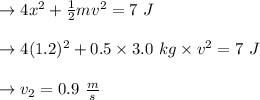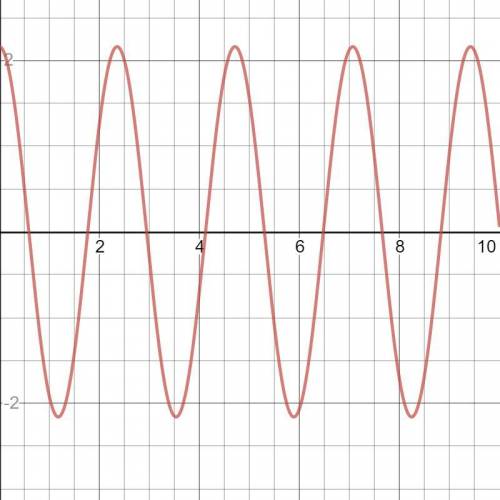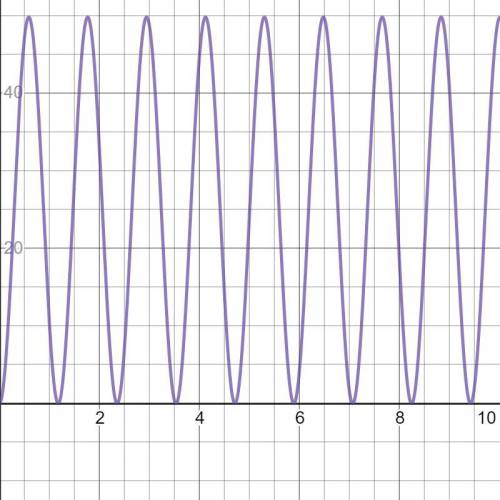
Physics, 04.04.2020 14:02 pearsonalyssa
A 3.0 kg object is moving along the x-axis in a region where its potential energy as a function of x is given as U(x) = 4.0x2 , where U is in joules and x is in meters. When the object passes the point x = -0.50 m, its velocity is +2.0 m/s. All forces acting on the object are conservative. Calculate the total mechanical energy of the object Calculate the x-coordinate of any points at which the object has zero kinetic energy. Calculate the magnitude of the momentum of the object at x = 0.60 m. Calculate the magnitude of the acceleration of the object as it passes x = 0.60 m. On the axes below, sketch graphs of the object’s position x versus time t and kinetic energy K versus time t. Assume that x = 0 at time t = 0 . The two graphs should cover the same time interval and use the same scale on the horizontal axes.

Answers: 3


Another question on Physics

Physics, 21.06.2019 12:50
"why is graphite used instead of gold or copper wires to conduct electricity in very hot situations such as an industrial kiln? " that's the question, but the thing is, i don't even understand what an "industrial kiln" xd assistance would be < 3
Answers: 2

Physics, 22.06.2019 00:30
Comedians like to joke that the reason we haven’t been visited by intelligent life from elsewhere in the universe is that aliens have been monitoring earth’s broadcasts of intellectually embarrassing tv programs, like gilligan’s island, fear factor, the jersey shore, and the jerry springer showand so consider us far too primitive to merit a visit. let’s check the assertion that aliens could have been receiving them. tv programs are broadcast at a frequency of about 100mhz with about 100kw of total power in 30frames per second, which emanatesroughly uniformly in all directions. assume that interstellar space transmits these broadcasts without attenuation. no matter how smart they are, aliens would require at least one photon per frame to interpret our signals. findthe number of photons per unit time per unit area reaching a receiver on a possible planet in the nearest star system, which is about 4 light-years away (a light-year is the distance light travels in a year). if aliens aimed a receiver or detector directly at earth, how big (in diameter) would it have to be to receive a photon per frame
Answers: 2

Physics, 22.06.2019 01:00
First, launch the video below. you will be asked to use your knowledge of physics to predict the outcome of an experiment. then, close the video window and answer the question at right. you can watch the video again at any point. part a as in the video, we apply a charge +q to the half-shell that carries the electroscope. this time, we also apply a charge –q to the other half-shell. when we bring the two halves together, we observe that the electroscope discharges, just as in the video. what does the electroscope needle do when you separate the two half-shells again? view available hint(s) as in the video, we apply a charge + to the half-shell that carries the electroscope. this time, we also apply a charge – to the other half-shell. when we bring the two halves together, we observe that the electroscope discharges, just as in the video. what does the electroscope needle do when you separate the two half-shells again? it deflects more than it did at the end of the video. it deflects the same amount as at end of the video. it does not deflect at all. it deflects less than it did at the end of the video. submit
Answers: 2

Physics, 22.06.2019 02:10
Astudent is performing an experiment comparing sound and light waves. the student gathers the following data. what conclusion does the student most likely make based on this data? light waves always travel the same speed; however, the speed of sound is determined by the medium that it travels through. all sound waves always have the same energy, so the temperature of the medium does not affect wave speed. light needs to vibrate particles, so it travels fastest in tightly packed solids, while sound does not need a medium, so it travels fastest in a gas. tightly packed particles in solids slow down the light waves; however, sound waves make particles bounce into each other, so they travel faster in solids.
Answers: 3
You know the right answer?
A 3.0 kg object is moving along the x-axis in a region where its potential energy as a function of x...
Questions


History, 14.07.2019 13:30

Business, 14.07.2019 13:30



Mathematics, 14.07.2019 13:30

Biology, 14.07.2019 13:30



Social Studies, 14.07.2019 13:30





Biology, 14.07.2019 13:30

Social Studies, 14.07.2019 13:30

Biology, 14.07.2019 13:30


Social Studies, 14.07.2019 13:30

Social Studies, 14.07.2019 13:30








 the velocity is found by
the velocity is found by 



 , b)
, b)  c)
c) 










![v = \sqrt{\frac{2\cdot [7\,J- 4\cdot (0.6\,m)^{2}]}{3\,kg} }](/tpl/images/0582/4528/5819a.png)














 is:
is:![v = \sqrt{\frac{2\cdot [7\,J- 4\cdot (0\,m)^{2}]}{3\,kg} }](/tpl/images/0582/4528/421d4.png)




![K = \frac{1}{2}\cdot (3\,kg)\cdot [33.178\cdot \sin^{2}(2.667\cdot t)]](/tpl/images/0582/4528/9bd1f.png)



